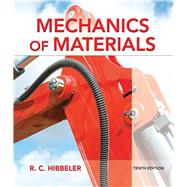Mechanics of Materials clearly and thoroughly presents the theory and supports the application of essential mechanics of materials principles. Professor Hibbeler's concise writing style, countless examples, and stunning four-color photorealistic art program help you visualize and master difficult concepts.
The 10th Edition retains the hallmark features synonymous with the Hibbeler franchise, and is enhanced with the most current information, a fresh new layout, added problem solving, and increased flexibility in the way topics are covered.
If you are not using Mastering Engineering, you can purchase access to the videos that accompany this title here.








